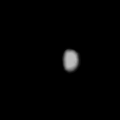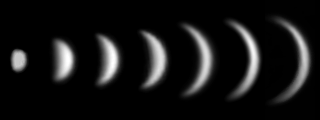



Known to the ancients as both the Evening Star and the Morning Star (it was some time before it was realised they were the same planet), opportunities to see Venus in the evening sky come around every 584 days (compared to 116 for Mercury). However, because Venus moves further away from the Sun in the sky than Mercury, each opportunity lasts for much longer - many months, in fact - and so on average it will be visible for about 41/2 months each year. Observing it is also easier because not only is the planet away from the glare of the Sun but also much brighter due to being considerably bigger than Mercury, nearer to Earth and covered with clouds (which reflect the sunlight). Being brighter, it is not only easier to spot but also visible well before sunset when the sky is not yet dark.
It's surprisingly easy to predict when Venus will be visible because 8 Earth years are equal to 13 venusian years (only 23hrs difference) and so events re-occur at almost exactly 8 year intervals. The table below gives the times when Venus is visible (in both the morning and evening skies), taking into account the fact that it has to be a reasonable distance away from both the Sun and the horizon to be actually viewable. To find which row to use subtract 2000 from the year, divide by 8 and note the remainder: for example, for 2012 use row 4. The changes from evening star to morning star are quicker than those from morning to evening because in the former case Venus is much nearer to the Earth and hence moving faster. Visibility is however compromised near the autumnal equinox, because at that time the planet's path across the sky keeps it very close to the horizon, so the switch takes somewhat longer then.
| Jan | Feb | Mar | Apr | May | Jun | Jul | Aug | Sep | Oct | Nov | Dec | |||||||||||||
| 0 | ||||||||||||||||||||||||
| 1 | ||||||||||||||||||||||||
| 2 | ||||||||||||||||||||||||
| 3 | ||||||||||||||||||||||||
| 4 | ||||||||||||||||||||||||
| 5 | ||||||||||||||||||||||||
| 6 | ||||||||||||||||||||||||
| 7 | ||||||||||||||||||||||||
| Visible as morning star | ||||||||||||||||||||||||
| Visible as evening star | ||||||||||||||||||||||||
| Not visible (superior conjunction/inferior conjunction) | ||||||||||||||||||||||||
Having been absent from the evening skies for quite some time, Venus swung out from behind the Sun in autumn 2003 but was not easily visible until the turn of the year. At first quite small, the planet slowly grew into an increasingly large crescent as its orbit took it nearer to the Earth. This was hard to notice while the planet's disc was small though so I didn't really start my photographic campaign until early April.
Always very bright, Venus' intensity actually makes photography more difficult. The brilliant white induces colour casts in the images which distort their shape and size, so the ones here have been reduced to monochrome to give a truer picture. Estimating the exposure to capture both the body of the planet and the "horns" of the crescent was also slightly tricky: the averaging effect obtained by combining several shots into one image helped a great deal here.
 |  |  |  |
| Here's one taken in late May 2005 to show Venus at almost full phase, and rather small. | But in early January 2004 Venus' disc is clearly non-circular - in fact it's about 80% illuminated. | By the beginning of April the phase is just less than half - the increase in size is now very noticeable. | At the end of April it's definitely turning into a true crescent. |
 |  |  |  |
| Just a week later and the horns are starting to curl round at top and bottom. | After a further fortnight the crescent has really thinned out. | Another week gone and just a thin sliver remains. | The final view before the planet gets too close to the Sun for effective observation. |
 |  | |
| Just to really make the point about the crescent increasing in size as it thins in width, here's a montage of all the images taken in 2004. | And an animation of it actually doing it. |